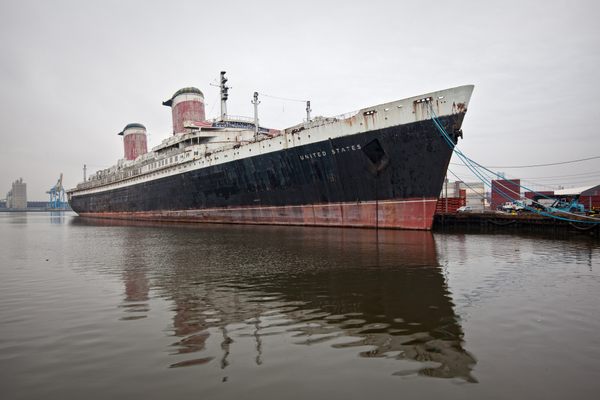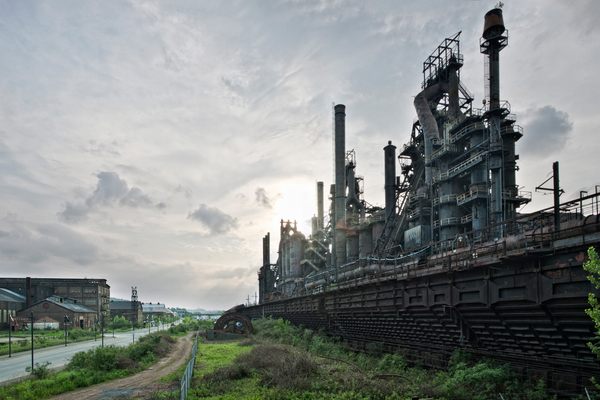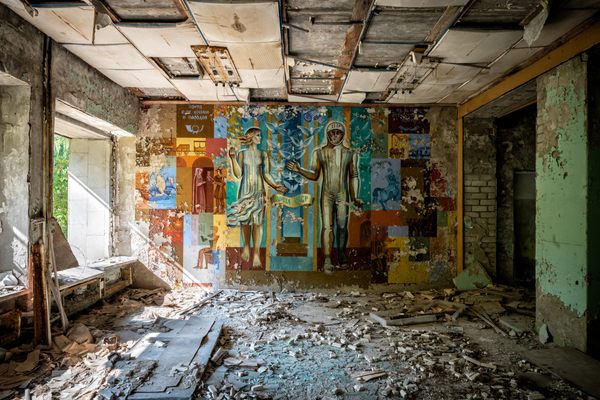
What Abandoned Schools Can Teach Us
Empty chairs, empty tables, and the dismantling of the American Dream.

Getting inside the abandoned Martin Luther King Jr. Middle School shouldn’t have been as easy as it was. It made me nervous, like it was a trap. The doors on the back of the building were wide open and, ducking inside, we made our way through the cavernous remains of the gymnasium. A pommel horse stood undisturbed in the center, but nearly every other surface, from the walls to the backboards of the basketball hoops, was smeared with graffiti. The school had closed just over a decade earlier. Still, the damage inside was appalling; The classroom floors were covered with plaster debris and, in some places, an admittedly beautiful carpet of moss. Glass display cases were shattered, and sharp, rusty bars from the drop ceilings jutted down into the hallways, ready to cut your head if you weren’t paying attention.
We passed lockers hanging ajar, covered with fading stickers, through the ruins of a large pool room, and finally to the school’s crown jewel: the massive auditorium. There was graffiti here, too, and stickers left on the seats memorializing an urban explorer who had recently passed away, but the long, luxurious red curtains on the windows and stage were intact, gently swaying as the building inhaled and exhaled through broken windows. As is often the case when exploring abandoned places, there was a sense of awe that comes with confronting something that seems too large and majestic to be left to rot, but somehow has been anyway.
Beneath the reverence, another emotion was bubbling up: anger. As I looked out across the grand theater from the stage and composed my shot, a quiet fury welled up in me. This was the third abandoned public school I’d photographed in a day. Every one was full of desks, books, and lab equipment, and every single one was well into a spiral of vandalism and decay from which it would likely never recover. Millions of dollars had been spent building and equipping these schools. Each one was part of a grand experiment, not even two centuries old, to provide education to the public regardless of income or upbringing. And here they were, treated like trash.


The public school system as we know it is a relatively new concept. Though the first taxpayer-funded public school was founded in Dedham, Massachusetts, in 1644, and Puritans quickly established schools upon their arrival in the colonies, most schools in the early days of the United States were organized by families or churches. They often charged tuition, which excluded anybody without the resources to pay. These schools were often difficult to reach, staffed by poorly paid, inexperienced teachers, and attendance wasn’t required.
In the 1830s, reformers like Horace Mann argued that public schools, or “common schools,” would bolster the nation’s economy by producing educated citizens instilled with civic virtues and should be provided without charge to all. This system, reformers argued, would reduce poverty and crime and provide an opportunity for advancement beyond the social class one was born into. The very idea of a meritocracy depended on each citizen being provided equal footing to grow and succeed based on their hard work and intelligence, rather than the amount of privilege they had been born into.
Even then, some critics resented the idea of using tax money to educate the children of others. There was also concern among education reformers that private schools would siphon off funding and students, perpetuating an inescapable caste system.

But by the 1870s, the public school system was relatively well-established, with 78 percent of children between five and 14 in the system. Though access lagged for nonwhite students, girls, and children with physical or developmental disabilities, progress was being made, and benefits to the public were immense. Literacy rates soared, guidelines and curricula were established, and the discourse that would lead to the decades-long battle culminating in the end of child labor in 1938 was taking root.
Publicly funded secondary schools, which we now would call high schools, didn’t rise to prominence until the early 20th century. It was during this period that Trenton Junior High School No. 1 opened in 1916. Construction took two years and cost $260,000 (equivalent to approximately $7.5 million today). It was built in the Collegiate Gothic architectural style, a mixture of Tudor and Gothic influences that had been popularized at places like Princeton and the University of Pennsylvania. Like the Northeast Manual Training School in Philadelphia (later renamed Thomas A. Edison High School), which opened in 1905, or the Schenley High School in Pittsburgh, built in 1916, Trenton Junior High School was established with pride and ambition, representing a massive public investment in the community surrounding it.
All three schools were beacons of hope in their communities, where generations of students studied, played sports, and sometimes returned to teach. All three were eventually left abandoned in the 2000s. Schenley was later converted to apartments, and students at Thomas A. Edison High School were moved to a newer school building nearby run by a for-profit company. Trenton Junior High School No. 1, which was renamed Martin Luther King Jr. Middle School in 1990, closed in 2007, not long after an ugly incident where the New Jersey Construction Corporation dumped construction materials between Martin Luther King Jr. Middle School and its neighbor, the Thomas Jefferson Elementary School, while classes were in session without properly ensuring dust was not spread throughout the buildings from the waste, which contained a frightening array of carcinogens and concrete aggregate, which can cause fatal lung disease when inhaled.

Surveying the wreckage of Martin Luther King Jr. Middle School, I found myself asking the same question I always do in the face of spectacular ruins: why in God’s name is this place abandoned? Was there really nothing better we could do?
The answer to that question is complicated. The public school system has taken a beating since the early 2000s: Since 2002, over a hundred schools have been closed in New York City alone, and during the 2009-2010 fiscal year, Detroit closed 73 of the 172 school buildings it had left. Across the country, budgets have been slashed, buildings shuttered, and teachers laid off.
According to the Public Accountability Initiative, “the austerity and privatization agenda for education goes something like this: impose big tax cuts for corporations and the .01 percent and then use declining tax revenue as a rationale to cut funding for state-funded services like public schools. Because they are underfunded, public schools cannot provide the quality education kids deserve.” This leads to vocal criticism that schools are underperforming and a push to hand over the reins of the school system to private corporations running charter schools. It seems there was some legitimacy to the 19th-century reformers’ fear that for-profit competitors could pose an existential threat to the public education system.
The arguments between proponents of charter schools and public schools can get heated. Charter school advocates argue that they provide smaller class sizes, more flexibility and innovation, more accountability for students, and greater specialization. But public schools require a standardized curriculum and education levels for teachers, greater accessibility for students regardless of needs and backgrounds, and more extracurricular opportunities. Some teachers at charter schools feel safer, but they also tend to get paid less and are not offered the protections afforded by unionization. Wading into the middle of this debate seems counterproductive when both charter schools and public schools have myriad strengths and weaknesses, often reflected to varying degrees in each individual facility. A school in one area may be fantastic, and one district over a comparable institution may be woefully mismanaged.
Whether or not one believes charter schools are the way of the future, it’s hard to argue that they are capable of covering the range of needs that public schools are capable of. Well-funded public schools must be a priority if we are even to pretend we are a nation of equal opportunity. The public school system is one of the most critical rungs in the ladder between social classes, and kicking it out eliminates social and economic mobility. Closing a public school disrupts students’ lives, forcing longer commutes and erasing the communities they have built.
The phrase “American Dream” was popularized by the American historian James Truslow Adams. According to his definition, it meant “that dream of a land in which life should be better and richer and fuller for every man, with opportunity for each according to ability or achievement.” To Adams, the American Dream was a meritocracy, where personal people should be seen “for what they are, regardless of the fortuitous circumstances of birth or position.” You can even trace support for public education back to the Founding Fathers—Thomas Jefferson passionately argued for free public schools, believing that they would prepare the populace to choose wise leaders.


Despite years of closures and budget cuts, some schools are fighting back: after parents, students, and teachers staged protests that included strikes, ousting and replacing school board members, and even an 18-day hunger strike, decisions to close schools in Oakland and Denver were reversed. These schools were predominantly attended by Black and Latino students; NEA Today reports that “while Black students account for just one-fifth of the overall Oakland student body, at four of the seven schools slated for closure, more than half of students are Black.” According to the U.S. News & World Report, 97.9 percent of students in the Trenton Public School District where Martin Luther King Jr. Middle School is located are Black or Hispanic/Latino.
Whether these victories represent an anomaly or part of a larger sea change toward protecting our public schools remains to be seen. It doesn’t matter for the Martin Luther King Junior Middle School, though: like the Thomas A. Edison High School in Philadelphia, it was destroyed by a fire and subsequently razed. Neighbors noticed flames shooting out of the building on May 15, 2023, shortly after five teens were spotted leaving one of the rear doors. These were probably the same doors left open when I visited it in 2018. Much as I appreciate an easily accessible entrance to one of the abandoned buildings I photograph, leaving a property unsecured for years greatly increases the odds that it will be a target for arson.
If you could somehow rewind time to before the fire, that moment when I had the building to myself is still out there somewhere. Go back a bit further, and hundreds of kids are celebrating their commencements in the auditorium or rolling their eyes at an assembly. Keep going through decades of that, and you’ll arrive at the point where the ground for the construction project was first broken. It’s a beautiful moment, one full of hope. They were starting a project to serve the public for centuries to come. Little did they know, it wouldn’t even make it through one.


For more about Martin Luther King Jr. Middle School, Thomas A. Edison High School, or Schenley High School, visit the Abandoned America website. You can also listen to the Abandoned America podcast here.
Matthew Christopher is a writer and photographer who has explored abandoned locations across the globe for two decades, chronicling the lost landmarks in our midst. You can find more of his work on his website Abandoned America or listen to his Abandoned America podcast.














Follow us on Twitter to get the latest on the world's hidden wonders.
Like us on Facebook to get the latest on the world's hidden wonders.
Follow us on Twitter Like us on Facebook